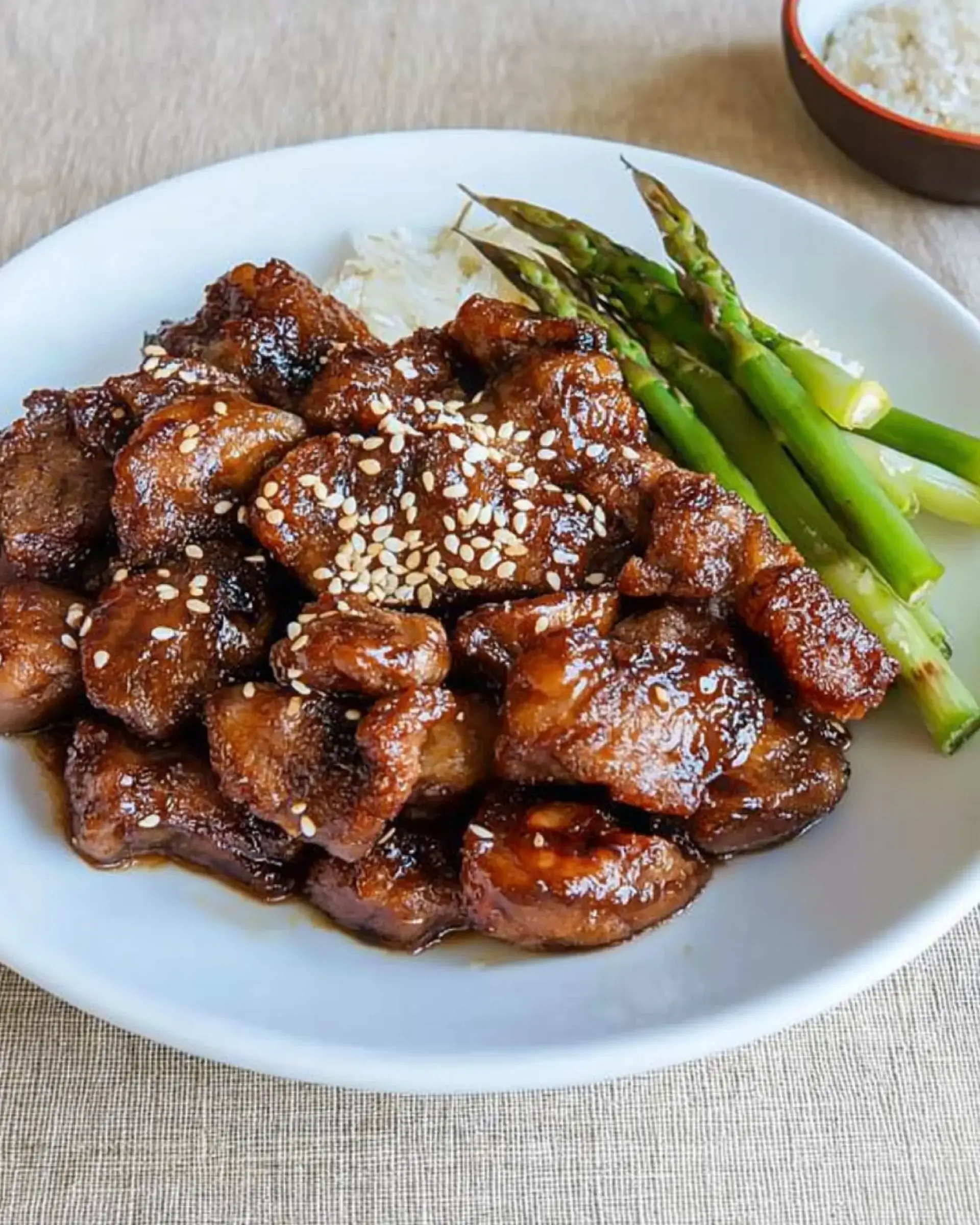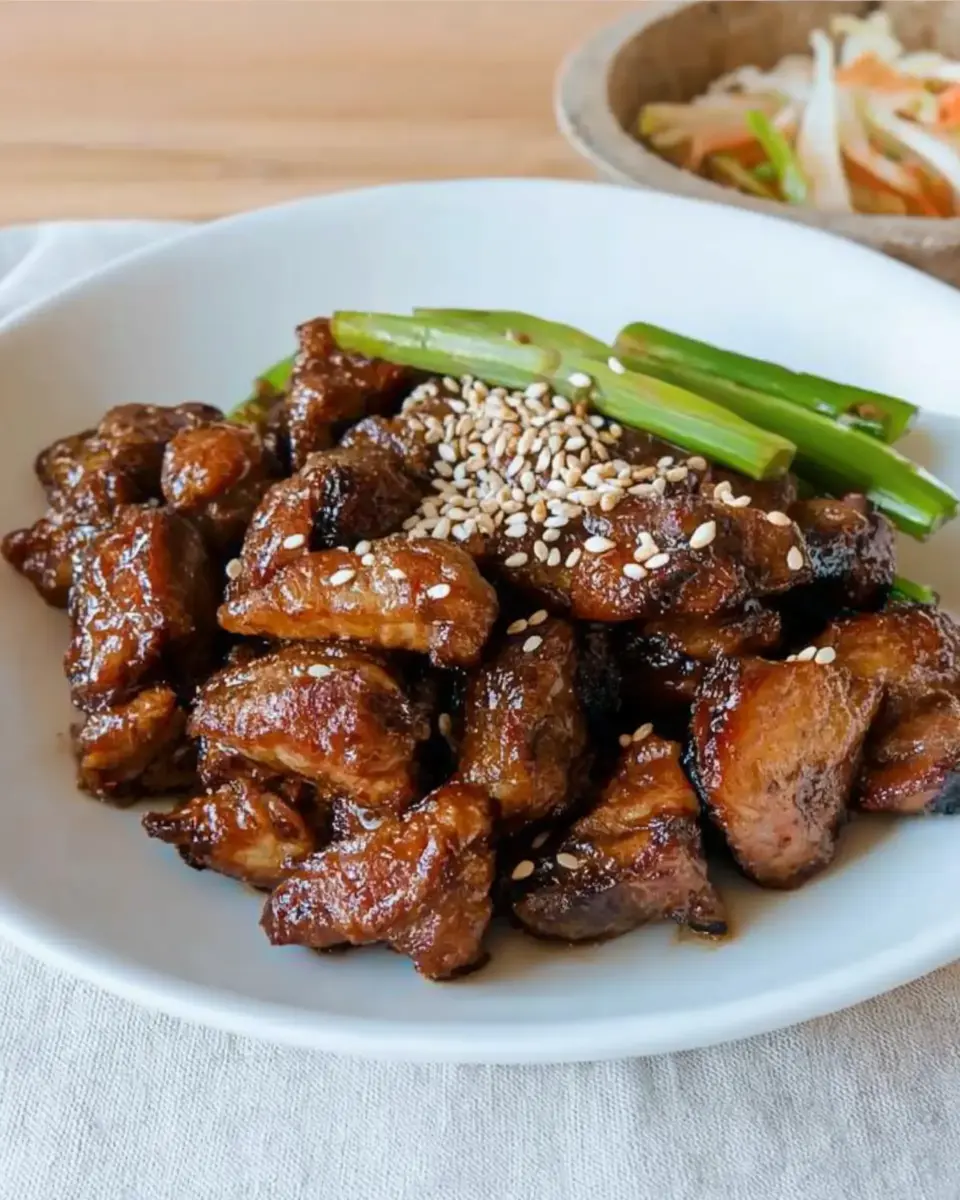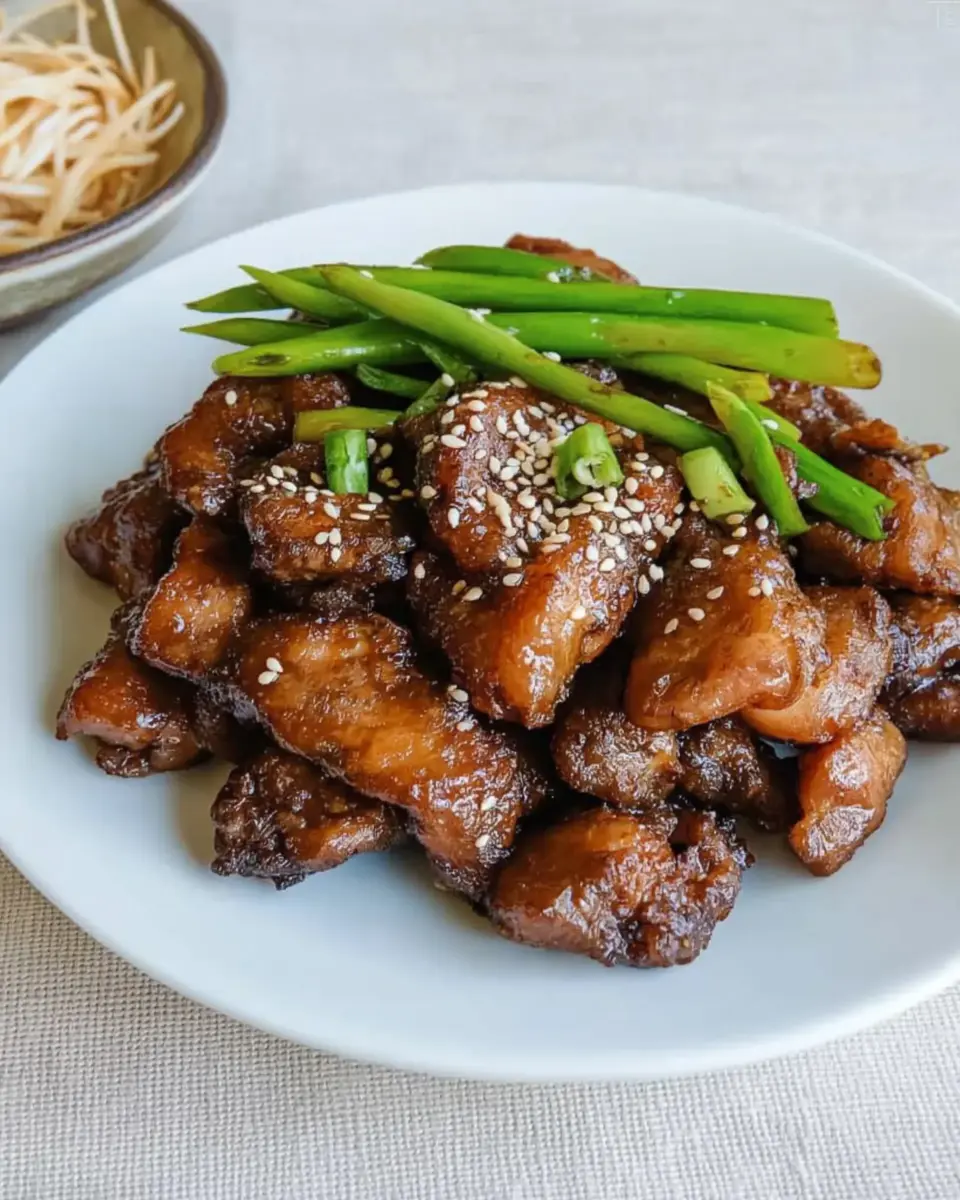
Introduction to Korean Pork Belly Skillet
There’s something magical about the sizzle of pork belly in a hot skillet.
The aroma wafts through the kitchen, instantly transporting me to my favorite Korean barbecue joint.
This Korean Pork Belly Skillet is not just a meal; it’s a celebration of flavors and textures that come together in a delightful dance.
Whether you’re looking for a quick solution after a long day or a dish to impress your loved ones, this recipe has you covered.
With vibrant vegetables and a savory sauce, it’s a healthy delight that’s sure to please everyone at the table.
Why You’ll Love This Korean Pork Belly Skillet
This Korean Pork Belly Skillet is a game-changer for busy weeknights.
In just 30 minutes, you can whip up a dish that’s bursting with flavor and nutrition.
The combination of tender pork belly and fresh veggies makes it a satisfying meal that doesn’t skimp on taste.
Plus, the one-pan method means less cleanup, allowing you to enjoy your meal without the hassle.
It’s a win-win for any home cook!
Ingredients for Korean Pork Belly Skillet
Creating a delicious Korean Pork Belly Skillet starts with gathering the right ingredients.
Here’s what you’ll need:
- Pork Belly: The star of the dish, it’s rich and flavorful, providing that melt-in-your-mouth texture.
- Vegetable Oil: This helps to sear the pork belly, giving it a crispy exterior. You can also use canola or avocado oil.
- Onion: Sliced onions add sweetness and depth to the dish, balancing the savory flavors.
- Garlic: Minced garlic brings a punch of flavor that elevates the entire skillet.
- Fresh Ginger: A touch of ginger adds warmth and a hint of spice, enhancing the overall taste.
- Low-Sodium Soy Sauce: This provides the umami kick without overwhelming saltiness, making it a healthier choice.
- Gochujang: This Korean chili paste adds heat and a unique depth of flavor. Adjust the amount based on your spice tolerance.
- Honey: A natural sweetener that balances the heat from the gochujang, creating a harmonious sauce.
- Rice Vinegar: This adds a tangy note, brightening the dish and cutting through the richness of the pork.
- Sesame Oil: A drizzle of sesame oil at the end gives a nutty aroma that’s simply irresistible.
- Green Beans: Fresh and crunchy, they add color and nutrition to the skillet.
- Red Bell Pepper: Sweet and vibrant, it complements the other ingredients beautifully.
- Green Onions: Chopped for garnish, they add a fresh bite and a pop of color.
- Sesame Seeds: These are optional but add a delightful crunch and visual appeal when sprinkled on top.
For exact measurements, check the bottom of the article where you can find everything listed for easy printing.
Feel free to get creative with your ingredients!
How to Make Korean Pork Belly Skillet
Cooking this Korean Pork Belly Skillet is a straightforward process that yields delicious results.
Let’s dive into the steps that will have your taste buds dancing in no time!
Step 1: Sear the Pork Belly
Start by heating the vegetable oil in a large skillet over medium-high heat.
Once the oil is shimmering, add the bite-sized pieces of pork belly.
Sear them for about 5-7 minutes until they turn golden brown and crispy.
This step is crucial; it locks in the flavor and gives that satisfying crunch.
Keep an eye on them, flipping occasionally for even cooking.
Step 2: Sauté Aromatics
With the pork belly beautifully browned, it’s time to add the aromatics.
Toss in the sliced onion, minced garlic, and ginger.
Sauté for 2-3 minutes until the onion becomes translucent and fragrant.
The combination of these ingredients will create a mouthwatering base for your dish.
Don’t rush this step; let those flavors mingle!
Step 3: Prepare the Sauce
In a small bowl, whisk together the low-sodium soy sauce, gochujang, honey, rice vinegar, and sesame oil.
This sauce is the heart of the dish, bringing everything together.
Pour it over the pork and onion mixture, stirring well to coat every piece.
The vibrant colors and aromas will make your kitchen feel like a Korean bistro!
Step 4: Combine and Cook
Now, it’s time to add the green beans and red bell pepper to the skillet.
Stir everything together and let it cook for another 5-7 minutes.
You want the vegetables to be tender but still crisp.
This is where the magic happens; the sauce thickens and clings to the ingredients, creating a delicious glaze.
Step 5: Garnish and Serve
Once everything is cooked to perfection, remove the skillet from heat.
Garnish with chopped green onions and a sprinkle of sesame seeds for that extra flair.
Serve your Korean Pork Belly Skillet hot, and watch as everyone digs in with delight.
Pair it with brown rice or quinoa for a complete meal that’s both satisfying and healthy.

Tips for Success
- Use a cast-iron skillet for even heat distribution and a perfect sear.
- Don’t overcrowd the pan; cook in batches if necessary for that crispy texture.
- Let the pork belly rest for a few minutes after cooking to enhance juiciness.
- Adjust the gochujang to your spice preference; start with less if you’re unsure.
- Experiment with seasonal vegetables for a fresh twist on this dish.
Equipment Needed
- Large Skillet: A non-stick or cast-iron skillet works best for even cooking.
- Spatula: A sturdy spatula helps flip the pork belly and stir the ingredients.
- Measuring Cups and Spoons: Essential for accurate ingredient measurements.
- Mixing Bowl: Use this for whisking together the sauce ingredients.
Variations
- Protein Swap: Substitute pork belly with chicken thighs, beef, or tofu for a different flavor profile.
- Vegetable Medley: Add or replace vegetables like zucchini, mushrooms, or snap peas for a colorful twist.
- Spice Level: For a milder version, reduce the gochujang or use a sweet chili sauce instead.
- Gluten-Free Option: Use tamari instead of soy sauce to make this dish gluten-free.
- Herb Infusion: Toss in fresh herbs like cilantro or basil at the end for an aromatic finish.
Serving Suggestions
- Serve the Korean Pork Belly Skillet over a bed of fluffy brown rice or quinoa for added fiber.
- Pair it with a crisp cucumber salad to balance the richness of the pork.
- A cold Korean beer or a light white wine complements the flavors beautifully.
- For presentation, garnish with extra sesame seeds and fresh herbs for a pop of color.

FAQs about Korean Pork Belly Skillet
Can I make this Korean Pork Belly Skillet ahead of time?
Absolutely! You can prepare the pork belly and sauce in advance. Just store them separately in the fridge. When you’re ready to eat, simply reheat and add the vegetables for a quick meal.
What can I substitute for gochujang?
If you don’t have gochujang, you can use a mix of red pepper flakes and a bit of honey for sweetness. It won’t be exactly the same, but it will still add a nice kick!
Is this dish suitable for meal prep?
Yes! This Korean Pork Belly Skillet is perfect for meal prep. Divide it into containers and store in the fridge for up to four days. Just reheat when you’re ready to enjoy!
How can I make this dish spicier?
To amp up the heat, add more gochujang or toss in some sliced fresh chili peppers. You can also serve it with a side of kimchi for an extra spicy kick!
Can I use a different type of meat?
Definitely! While pork belly is delicious, you can swap it for chicken thighs, beef, or even tofu for a vegetarian option. Just adjust the cooking time accordingly.
Final Thoughts
Cooking this Korean Pork Belly Skillet is more than just preparing a meal; it’s about creating a moment.
The blend of savory pork, vibrant veggies, and that irresistible sauce brings joy to the table.
Each bite is a reminder of the warmth of home-cooked meals and the love that goes into them.
Whether you’re sharing it with family or enjoying it solo, this dish is sure to leave a lasting impression.
So, roll up your sleeves, embrace the flavors, and let this Korean Pork Belly Skillet become a cherished part of your culinary repertoire!
Korean Pork Belly Skillet: A Healthy Delight Awaits
Ingredients
Method
- Heat the vegetable oil in a large skillet over medium-high heat. Add the pork belly and cook until browned and crispy, about 5-7 minutes.
- Add the sliced onion, garlic, and ginger to the skillet. Sauté for 2-3 minutes until the onion is translucent.
- In a small bowl, whisk together the soy sauce, gochujang, honey, rice vinegar, and sesame oil. Pour the sauce over the pork and onion mixture, stirring to coat.
- Add the green beans and red bell pepper to the skillet. Cook for another 5-7 minutes, stirring occasionally, until the vegetables are tender and the sauce has thickened.
- Remove from heat and garnish with chopped green onions and sesame seeds before serving.
Nutrition
Notes
- For a lighter version, substitute pork belly with chicken thighs or tofu.
- Serve over brown rice or quinoa for added fiber.
- Adjust the level of gochujang to suit your spice preference.

